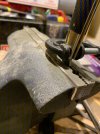-
The BladeForums.com 2024 Traditional Knife is available! Price is $250 ea (shipped within CONUS).
Order here: https://www.bladeforums.com/help/2024-traditional/
You are using an out of date browser. It may not display this or other websites correctly.
You should upgrade or use an alternative browser.
You should upgrade or use an alternative browser.
Fixing blade rub/centering?
- Thread starter Wild Willie
- Start date
dsutton24
Gold Member
- Joined
- Apr 9, 2018
- Messages
- 2,139
Two minor points...
Blade krinking can lead to blade breaking. It's been mentioned before, but I though that this point should be emphasized. If you're dying to try it, start with an already broken knife as similar as possible to your victim.
The second point is ninety percent curmudgeonly: The obsession over blade clash or centering is largely internet driven. Lots of perfectly good knives, cars, escalators, and root vegetables get ruined every year by owners or brothers-in-law reading something on the internet and going at them with a vise and hammer. The trick is knowing when to leave well enough alone.
Blade krinking can lead to blade breaking. It's been mentioned before, but I though that this point should be emphasized. If you're dying to try it, start with an already broken knife as similar as possible to your victim.
The second point is ninety percent curmudgeonly: The obsession over blade clash or centering is largely internet driven. Lots of perfectly good knives, cars, escalators, and root vegetables get ruined every year by owners or brothers-in-law reading something on the internet and going at them with a vise and hammer. The trick is knowing when to leave well enough alone.
- Joined
- Jun 9, 2010
- Messages
- 4,333
Two minor points...
Blade krinking can lead to blade breaking. It's been mentioned before, but I though that this point should be emphasized. If you're dying to try it, start with an already broken knife as similar as possible to your victim.
The second point is ninety percent curmudgeonly: The obsession over blade clash or centering is largely internet driven. Lots of perfectly good knives, cars, escalators, and root vegetables get ruined every year by owners or brothers-in-law reading something on the internet and going at them with a vise and hammer. The trick is knowing when to leave well enough alone.
I guess we have different opinions of what's a "perfectly good knife". If the blade is laying against one liner or the other, I don't consider it a good knife, and will take my chances with it breaking. There's also the fact that, for me, it worked and did NOT break, twice.
 YMMV
YMMV- Joined
- Mar 25, 2005
- Messages
- 1,644
Pinemoon What kind of steel are the knives?
The steel on the Boker is C75
The Rough Rider just says 440
The big unknown about doing that on knives is are the tangs annealed? Every company does or did things differently. I'm sure some companies don't anneal them at all and skip the crinking completely, letting the blades fall where they may. Trying to crink one of these blades is a recipe for disaster. Sometimes you have to whack a blade pretty hard to get it to move, but not knowing the hardness of the tang is really taking a chance. That's why I say unless the blade is actually rubbing the liner you might be better off leaving it alone. Of course if it's a cheapo disposable then whack away.
You definitely don't need a chisel with a 7oz hammer, I only mentioned that for those folks who only have something like a big claw hammer or framing hammer. etc. Those are a bit on the large side
The mallet I used in the video was one pound including the handle, the head was probably about twelve or 13 ounces by itself. I crinked everything from little whittler coping blades to big 'ol folding hunter blades with that hammer. The important thing is knowing how hard to hit the blade, and the only way to master that is through trial and error. Believe me I sent folks ducking for cover more than once!
Eric
Thanks Eric,
Some good insights there. The Rough Rider I'm trying this on is a cheapo so I'm game for whatever.
One question I have is , are we trying to move the blade/tang on the pivot, or are we trying to "curve" the blade a bit, or something else entirely?
The steel on the Boker is C75
The Rough Rider just says 440
Thanks Eric,
Some good insights there. The Rough Rider I'm trying this on is a cheapo so I'm game for whatever.
One question I have is , are we trying to move the blade/tang on the pivot, or are we trying to "curve" the blade a bit, or something else entirely?
You’re trying to bend the blade.
I haven’t tried this method and it certainly looks interesting, but I think it’s a bad idea to do it this way. It’s a lot of force very quickly in a very concentrated area. The way I’ve done it, and I’ve done it numerous times, is to put the blade in a vise and bend it that way. I think it greatly reduces the risk of breaking the blade but also adds to the options of centering, because if the blade won’t bend generally the frame will, it seems that depending on if it is the blade that is bending you have to bend in the opposite direction as if the frame is what’s bending. If you put the blade in the vise with the tang visible you can bend it there, this can loosen the blade but it can be re-piened. I have started putting a small screw clamp on either side of the bolster to keep it from loosening which works well.
This is a great thread & my thanks to all for contributing to it. Blade centering is a MAJOR pet peeve of mine & I have sold quite a few Case's over the years due to improper centering. I like single blades such as slimline trappers, mini trappers (107W's), peanuts, etc... and more often than not, they are poorly centered (it's SO MUCH more noticeable and annoying in a single blade knife).
Has anybody tried this krinking technique with a common Case SS stainless steel blade ?
Thank you -
Has anybody tried this krinking technique with a common Case SS stainless steel blade ?
Thank you -
- Joined
- Mar 25, 2005
- Messages
- 1,644
Thanks for your input.You’re trying to bend the blade.
I haven’t tried this method and it certainly looks interesting, but I think it’s a bad idea to do it this way. It’s a lot of force very quickly in a very concentrated area. The way I’ve done it, and I’ve done it numerous times, is to put the blade in a vise and bend it that way. I think it greatly reduces the risk of breaking the blade but also adds to the options of centering, because if the blade won’t bend generally the frame will, it seems that depending on if it is the blade that is bending you have to bend in the opposite direction as if the frame is what’s bending. If you put the blade in the vise with the tang visible you can bend it there, this can loosen the blade but it can be re-piened. I have started putting a small screw clamp on either side of the bolster to keep it from loosening which works well.
I will try the vise technique on my Rough Rider. It's my "experiment" knife
- Joined
- Mar 19, 2018
- Messages
- 4,378
Keep us posted on that. I'm glad you have the intestinal fortitude to experiment. I can't bring myself to do it with a knife I've hardly used.Thanks for your input.
I will try the vise technique on my Rough Rider. It's my "experiment" knife
- Joined
- Mar 25, 2005
- Messages
- 1,644
Haha, will do.Keep us posted on that. I'm glad you have the intestinal fortitude to experiment. I can't bring myself to do it with a knife I've hardly used.
- Joined
- Apr 3, 2009
- Messages
- 3,283
Bottom line here is your trying to slightly bend the blade in the ricasso area. There are many ways to skin a cat on this. Each and every way if not done carefully will most likely result in catastrophic failure. I've done them successfully in a vise, on blocks with hammers while still in the knife and while disassembled. If you have any mechanical aptitude it's not rocket surgery. If your all thumbs and your worried about ruining your knife I suggest you either send it to the manufacturer or someone who knows what their doing.
- Joined
- Mar 25, 2005
- Messages
- 1,644
Well, tried the vise method on my Rough Rider.
No luck.
I put a c-clamp on the pivot to support things. I am very mechanically inclined; I fix all sorts of things from soldering pipes to doing my own maintenance on my 2013 Suzuki outboard. I have tons of tools and was a professional woodworker for years. I've even given a Case Trapper some new handle scales, so I consider myself better than average in the workshop.
I'm gonna hold off on anymore tweaking. I don't wanna break the knife. It isn't worth the trouble to send it to anyone.
That said, I'm curious how anyone else makes out.
Maybe the steel on this Rough Rider is part of my problem Signalprick
??
Signalprick
??
It's 440 something-or-other
No luck.
I put a c-clamp on the pivot to support things. I am very mechanically inclined; I fix all sorts of things from soldering pipes to doing my own maintenance on my 2013 Suzuki outboard. I have tons of tools and was a professional woodworker for years. I've even given a Case Trapper some new handle scales, so I consider myself better than average in the workshop.
I'm gonna hold off on anymore tweaking. I don't wanna break the knife. It isn't worth the trouble to send it to anyone.
That said, I'm curious how anyone else makes out.
Maybe the steel on this Rough Rider is part of my problem
It's 440 something-or-other
- Joined
- Apr 3, 2009
- Messages
- 3,283
This is my guess on this one.Thinking a bit more, I'm probably encountering what Eric said earlier. The tang probably isn't annealed on the Rough Rider. I doubt these budget pieces have that extra step.
- Joined
- Mar 25, 2005
- Messages
- 1,644
Thanks for your helpThis is my guess on this one.
Will Power
Gold Member
- Joined
- Jan 18, 2007
- Messages
- 33,576
Slightly off-topic but this has to do with bending blades.
If you can krink, bend or straighten a blade, much may depend on its hardness I suppose? Trying it out on D2 which I think has a RW hardness about 61 on former Queen knives could be tricky, snap! but the opposite seems true on softer steels. Over Christmas I got out a Wright's Sheffield Ettrick which I thought would make an excellent knife for slitting Chestnuts to make sauce/stuffing with. The Ettrick is a short bladed Wharncliffe with a long handle-just right for scoring the Chestnuts, so I thought. Turns out not
but the opposite seems true on softer steels. Over Christmas I got out a Wright's Sheffield Ettrick which I thought would make an excellent knife for slitting Chestnuts to make sauce/stuffing with. The Ettrick is a short bladed Wharncliffe with a long handle-just right for scoring the Chestnuts, so I thought. Turns out not Now Wharncliffes can have a notoriously fragile tip, leading to breaking, but I imagined that as it was a very short blade it would be OK and Chestnuts are not that tough either, they're not Almonds
Now Wharncliffes can have a notoriously fragile tip, leading to breaking, but I imagined that as it was a very short blade it would be OK and Chestnuts are not that tough either, they're not Almonds The tip did not break but it curled over like an opened tin
The tip did not break but it curled over like an opened tin can't imagine how soft that steel must be but I had a curly tip after a couple of Chestnuts. A SAK with a small pruner finished off the job with no scars-and SAK stainless is fairly soft anyway, but that Wright seemed like a lead blade, back in the vice and all straight but it loves to bend....
can't imagine how soft that steel must be but I had a curly tip after a couple of Chestnuts. A SAK with a small pruner finished off the job with no scars-and SAK stainless is fairly soft anyway, but that Wright seemed like a lead blade, back in the vice and all straight but it loves to bend....
If you can krink, bend or straighten a blade, much may depend on its hardness I suppose? Trying it out on D2 which I think has a RW hardness about 61 on former Queen knives could be tricky, snap!
Chestnuts don’t even have very hard shells. Could it have softened while grinding or something? Regarding blade centering I decided to give the hammer method a shot, it didn’t work for me, I’ll post pics, the first is after trying it, the blade didn’t move, could have done something wrong but I don’t think so, and I had to hit it with a hammer harder than I think I want to. The other pics are of how I currently center blades and the results.Slightly off-topic but this has to do with bending blades.
If you can krink, bend or straighten a blade, much may depend on its hardness I suppose? Trying it out on D2 which I think has a RW hardness about 61 on former Queen knives could be tricky, snap!but the opposite seems true on softer steels. Over Christmas I got out a Wright's Sheffield Ettrick which I thought would make an excellent knife for slitting Chestnuts to make sauce/stuffing with. The Ettrick is a short bladed Wharncliffe with a long handle-just right for scoring the Chestnuts, so I thought. Turns out not
Now Wharncliffes can have a notoriously fragile tip, leading to breaking, but I imagined that as it was a very short blade it would be OK and Chestnuts are not that tough either, they're not Almonds
The tip did not break but it curled over like an opened tin
can't imagine how soft that steel must be but I had a curly tip after a couple of Chestnuts. A SAK with a small pruner finished off the job with no scars-and SAK stainless is fairly soft anyway, but that Wright seemed like a lead blade, back in the vice and all straight but it loves to bend....



So, is the consensus that the crinking or vice bending techniques are better left to carbon steel (I have been hoping for a response from anyone who may have been successful with Case TruSharp or similar stainless steel ... is that a Case barlow in the vice pics above ?) I'm going to try it weds on a TruSharp Case Jack & will report back... unless somebody talks me down
Last edited:
Slightly off-topic but this has to do with bending blades.
If you can krink, bend or straighten a blade, much may depend on its hardness I suppose? Trying it out on D2 which I think has a RW hardness about 61 on former Queen knives could be tricky, snap!but the opposite seems true on softer steels. Over Christmas I got out a Wright's Sheffield Ettrick which I thought would make an excellent knife for slitting Chestnuts to make sauce/stuffing with. The Ettrick is a short bladed Wharncliffe with a long handle-just right for scoring the Chestnuts, so I thought. Turns out not
Now Wharncliffes can have a notoriously fragile tip, leading to breaking, but I imagined that as it was a very short blade it would be OK and Chestnuts are not that tough either, they're not Almonds
The tip did not break but it curled over like an opened tin
can't imagine how soft that steel must be but I had a curly tip after a couple of Chestnuts. A SAK with a small pruner finished off the job with no scars-and SAK stainless is fairly soft anyway, but that Wright seemed like a lead blade, back in the vice and all straight but it loves to bend....
I've batonned a Queen D2 toothpick without the blade snapping. (Yes it's knife abuse...but I was younger then
